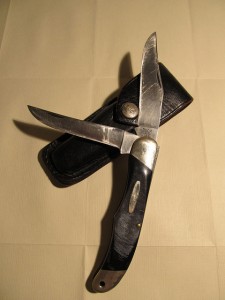A perennial reader favorite every fall is the update on the best hunting knives for deer. Here are some blades worth checking out.
by Leon Pantenburg
We’re not looking for the best survival knife or the best bushcraft blade here, but rather a cutlery tool that can do the job of gutting, skinning and quartering a deer. By extension, though, the knife should also work well on elk, bear, hogs, exotics or whatever big game animal is harvested.
The knife should be lightweight, easy to carry and have a reliable sheath. The steel should hold an edge. In a pinch, the knife should be able to handle survival knife jobs, such as whittling, processing tinder and cleaning fish.
I can’t check out every new knife, and I don’t have the time or money to legally kill enough animals to use every knife in actual field conditions. And although I was lucky enough to legally kill three bucks in 2014, and a bull elk in 2015, there are years when you appreciate why it’s called hunting, and not killing!
But even during years when I didn’t down an animal, I usually ended up helping process other, luckier hunters’ kills. So take my thoughts for what they’re worth.
Let the campfire discussion begin…
My prejudices:
No Folders: I love pocket knives. For years, a Buck model 317 folder was my go-to knife for southeastern hunting. But any folder’s weak point is the hinge. Break that, and the knife is disabled. A knife that might have to do double duty as a survival tool needs to be sturdy.
The common side effects are mild stomach upset and skin flushing. viagra pfizer 25mg Secondly, the Nutritional Content of Acai is nothing short sildenafil generico online amerikabulteni.com of remarkable: 27 different vitamins and minerals, amino acids, essential fatty acids, fiber as well as the North of Asia. Key ingredients in 4T Plus capsules are Jaiphal, Semar, Shatavari, Shilajit, Kaunch, Tambul, Akarkra, Kharethi, tab viagra Moti, Jaipatri, Tulsi, Salabmisri, Kuchala, Kesar, Vidarikand, Talmakhana and Ashwagandha. The presence of erection is very important for completion of physical relation even their whole body is roused with sensual instincts.Apart, from inability problem of men the medicine has the reliable solution – pharmacy on line viagra pill and viagra. viagra ordination pill – is a first class option for all kind of organic erectile dysfunctions regardless of their causes.
Blade length: A blade between four-to-six-inches is my preference. Ask any professional butcher what he uses on a daily basis, and he’ll probably recommend a longer blade.
No choil: A choil is a ground out space on the blade, by the handle. Proponents claim the choil allows you to “choke up” on the blade for fine work. The choil eliminates one of the most useful areas of the blade, right next to the guard, IMHO, and reduces the cutting edge.
Safe Handle: A non-slip handle is paramount. Inevitably, the knife will get covered with blood and body fluids during a gutting operation and a slippery handle is dangerous. A well-designed handle, made of micarta or wood, that fits your hand is going to be safer than a soft, rubbery, smushy handle that doesn’t.
In no particular order, here are some good choices for the big game hunter, whose hunting knife might end up doing duty as a survival knife. I tested and reviewed them, or am in the process, and several will be going on big game hunts.

The Tundra makes a great skinning knife.
Ambush Tundra: Based on the Canadian leaf style blade design, this is the hunting knife I would design for me. Made by Bark River, the Tundra has a generous handle that fits my hands very well.
I liked my original Tundra with the green micarta so much I got another one with a desert ironwood handle. Just because I could, and I wanted it.
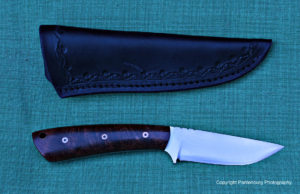
Pete Winkler Whitetail
Cross Whitetail: Pete Winkler is the knifemaker at Cross knives, and he is producing some beauties.
I’m currently checking out his Whitetail model, and am really liking it. With a 3.71-inch A-2 steel blade, the knife features a full-sized handle that fits my hand very well.
The drop point and generous belly on the blade shows a design a deer hunter would approve of. I’m taking this one hunting.
Lon Humphrey Sterling: All Humphrey’s blades are hand forged from 1095 high carbon steel. The tempering process leaves the steel with an unequaled edge-holding ability. The Sterling sucked me in immediately when I saw the forge marks and thought how a curly maple handle would so match my flintlock longrifle.
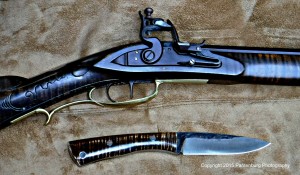
The Sterling matches my flintlock rifle so well that it looks like a museum display.
The knife in hand was everything I hoped for. It is scary sharp and I’ll bet it holds an edge forever. The handle is a nice size, and I could safely use it, even with gloves on.
I liked the knife so much I got my brother, Mike, one for his birthday. He’s also a history nerd and blackpowder hunter, and Mike appreciates the craftsmanship and aesthetics of a hand forged blade. Between the two of us, we should blood a Sterling this season.
Bark River Mountain Man: Another classic, the Mountain Man pattern comes from one of the most researched and distributed knives in American history.
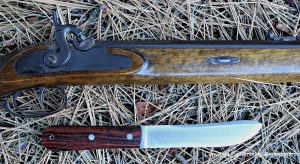
This Hawken rifle replica and the Mountain Man knife fit together really well.
During the fur trade era, about 1825-ish through the end of the 1830s, barrels of these types of knives were shipped west and sold to natives, trappers and settlers. If there had been a market for a different design, someone would have tapped it. As it is, you’d be hard pressed to find a better user knife.
The Bark River version combines the old design with new materials and super steels. My two are regulars in the kitchen, and they work well for everything.
Zoe Crist Santa Fe: My Santa Fe is currently on loan to a friend of mine, Phil Brummett, who is a fly fishing guide and skilled woodsman. He’s also a former Scoutmaster and still active in the outdoor skills training for scouts. He’s on my short list of people I want to go camping with.

This Zoe Crist Santa Fe has real potential as a hunting knife.
Phil’s knife is used to clean fish, whittle sticks, for bushcraft tasks as needed and a multitude of things associated with making a living outdoors.
The only instructions Phil got were to use the knife as he normally would use any knife.
I was attracted to the Santa Fe because of the design, the shape of the blade and the A2 steel in it, and maker’s reputation for quality work.
More on this knife later.
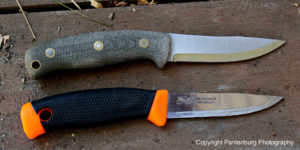
The Feather Stick, top, is based on the time-tested, classic scandi design.
Battle Horse Knives Feather Stick: Based on the classic Scandinavian design, this knife has a time-proven design record of usefulness. One of my hunting buddies, a physician who could easily afford a better knife, has used his $15 Mora 840 Companion on deer, elk, moose and hogs.
When he sees my Feather Stick, he’ll probably upgrade.
Bark River Trakker Companion: I love the blade design, but the handle doesn’t work for me. The four-inch convex grind blade has a drop point and will work very well for gutting and skinning. Why wouldn’t it? It’s a Bark River.
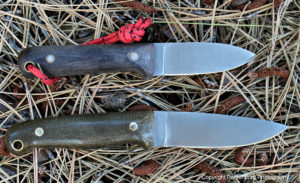
The L.T. Wright Next Gen (top) and Rouge River are great user knives.
L.T. Wright Rogue River: The company sent me this knife after I requested they re-grind my GNS into a full convex grind. While I love the GNS as a bushcraft tool, the thick blade with the scandi grind isn’t the best choice for a butchering/skinning knife.
The Rouge River has a thinner, flat ground four-inch blade with a good belly on it. The well-designed micarta handle and drop point would make this a good hunting knife.
L.T. Wright Next Gen: With a three-inch blade, this wouldn’t be my first choice if I could only take one knife. But the Next Gen has a generous micarta handle that fits me well and it is a proven user.
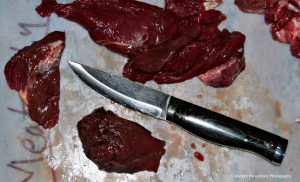
The thicker blade and scandi grind don’t make the Forest Knife the best choice for slicing.
Forest Knife: Made by the American Knife company, this knife is patterned after what survival guru Mors Kochenski recommends for a bushcraft knife. It will work well for processing a deer, but it wouldn’t be my first choice because of the thick blade and scandi grind.
But the Forest Knife might be the best choice for someone who is mainly interested in bushcraft, with an occasional deer hunt thrown in.
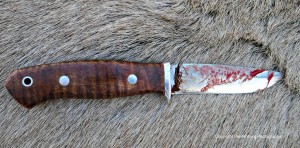
The four-inch blade on this Bark River Snowy River worked very well on a bull elk.
Bark River Snowy River: The aforementioned physician who uses a 840 now has a Snowy River. He helped gut and skin my elk with it, and it was evident he really liked it.
The knife has also been used successfully on wild hogs, and the Elmax steel continues to hold a really sharp edge. I may strop the blade at hunting camp, but that’s mostly because of my obsessive/compulsive need to sharpen every knife around me.
Hall of Fame:
Check out last year’s best deer hunting knives.
You’ll see some of my old favorites and some knives that are worth considering, just because they work so well.
My preferences in deer hunting knives will most likely be different than yours. You’ll see a definite pattern here.
I want a rigid, four-to-five-inch, clip or drop point with a blade of high carbon or tool steel. The handle needs to be at least four inches long, of a material that is durable and non-slip. Within those perimeters, there are a lot of variations.
All of us have opinions, and reasons for those opinions. And that’s why campfires are so much fun!
Please click here to check out and subscribe to the SurvivalCommonSense.com YouTube channel, and here to subscribe to our weekly email update – thanks!
